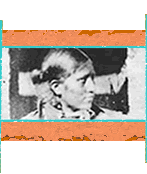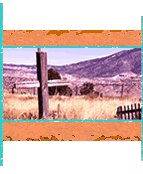





 |
 |
 |
 |
 |
 |
 |
The story of the Abiquiú Genízaro Land Grant is one full of rich history with many memories of times of struggle. To fully understand this history, it would be beneficial to do one's own research to learn what the people of this area went through just to hold on to what was rightfully theirs. The observations and facts we provide here in this exhibition are just a small part of the big picture, but we hope to give insight to the public about the struggles of the people in Abiquiú and the strength they have portrayed in overcoming many obstacles on the path to survival and prosperity. |
|
|
|
|
|
||
The population of the town of Abiquiú was listed as 621.
( Abiquiú, New Mexico Story )
The ALBUQUERQUE JOURNAL for August 29, 1949, tells this story: "A couple of years ago Arthur Newton Pack's 30,000-acre Ghost Ranch near Abiquiú, New Mexico, became the scene of one of the greatest finds in the history of ancient fossil remains." ( Abiquiú, New Mexico Story )
A new church replaced the old. Rev. Bickhaus dedicated this also to Santo Tomás. ( Abiquiú, New Mexico Story )
The Land Claim Court issued a patent to the Abiquiú Board of Grant Comissioners on November 11th.
The Abiquiú Grant was submitted to the Court of Private Land Claims in 1892 and confirmed in 1894. (www.rioarribanm.com/Abiquiú%20Grant.htm )
The military post at Abiquiú became a reality by January 31st. General Cyrus Choice was made the first Indian agent at the post at the same time. His first task was to solve the mystery of several murders committed near Abiquiú on January 3rd,1850, and to break up the friendship of the Abiquiú traders for the Ute Indians. ( Abiquiú, New Mexico Story )
Abiquiú played little part in the Revolution of 1837, although a number of the men did go to Santa Cruz and Santa Fe to enlist in the revolt against governor Perez. The militia at Abiquiú also mustered to ward off the invasion by Texans in 1841. ( Abiquiú, New Mexico Story )
The southern boundary of the Abiquiú Genízaro Grant was the subject of a long dispute with the Vallecitos de San Antonio, or Vallecitos Grant to the south between the 1820's and 1831 when the dispute was finally settled. The primary issue was the location of the road to Navajo land. The remaining Genízaros at the pueblo almost rioted when an attempt was made to locate the road 5,000 varas south of the center of the pueblo instead of the 10,000 varas called for in the Vélez Cachupín Grant. Finally a measurement of approximately 10,000 varas was made south of the center of the pueblo where the road (probably the beginning of the Old Spanish Trail ) was found near an old boundary marker (probably the one set by Vélez Cachupín in 1754 ). (www.rioarribanm.com/Abiquiú%20Grant.htm )
Cristóbal Quintana petitioned Governor Baca to authorize the distrubution and partition of the individual farm tracts within Abiquiú pueblo. The request was granted but proved to be a difficult and contentious process that was not fully completed until 1841 when land was distributed to members of the pueblo. (The Abiquiú Genízaro Grant, Malcolm Ebright)
At the time of the partitions of private farmlands at Abiquiú in 1825, the southern boundary of the pueblo of Abiquiú was recognized as "the road of the Tiquas that goes to Navajo." (The Abiquiú Genízaro Grant, Malcolm Ebright)
The decline in farming at Abiquiú and the 1812 laws of Spanish Cortés allowing privatization of unused pueblo lands set up a situation that was ripe for exploitation by hispanic citizens, including the priest at Abiquiú, Fray Theodoro Alcina.
Teresa Cortés sold lands she had acquired from Abiquiú pueblo to José Velarde, but three years later in 1815 Governor Alberto Máynez revoked the sale when the pueblo protested with stating that " no one can sell pueblo land, and if any has been sold the sale is null and void. (www.rioarribanm.com/Abiquiú%20Grant.htm )
Fray José de la Prada reported a total of 315 families of which 375 were adults. He said that he had performed 13 marriages at Abiquiú; 42 baptisms; and 18 funerals. Padre Eulogio Valdéz, who was in charge several years later, totaled the population as 90 for the male population of Genízaros; 86 female. The spaniards he listed as 330.
( Abiquiú, New Mexico Story )
The placita de Santa Rosa de Abiquiú-for obvious reasons-dwindled down to nineteen families. How many were killed by Indians is not known; probably about as many as were scared off were carried off. The Utes, Comanches and Apaches had good markets for the captives they wished to carry off.
( Abiquiú, New Mexico Story )
The district was ravaged by a terrible epidemic [unknown] that lasted for two months, carrying off a frightful number of victims.
( Abiquiú, New Mexico Story )
Father Domínguez made his visitation and census counting 46 Genízaros with 136 persons and 49 Spaniards with 254 persons. (www.rioarribanm.com/Abiquiú%20Grant.htm )
"Thieves from the Navajo Apaches have come on six occasions," wrote governor Mendinueta to the viceroy, "to steal cattle and horses from the pueblos of Jemez, Zía, San Ildefonso, the district of Abiquiú, and the jurisdiction of Albuquerque. Each time they were pursued by the settlers and Indians. In one attack the latter killed two Navajos and a women and retrieved the loot stolen from the Jemez Indians. On another occasion, the Navajos were only deprived of the theft by the San Ildefonso Indians. A Navajo was killed by the lieutenant of Abiquiú, another one was wounded, and the animals which they were driving off gotten back; the rest escaped over bad land." ( Abiquiú, New Mexico Story )
The Alcalde at La Cañada wrote to Governor Mendinueta in September that more than a thousand Comanches invaded the district, and frontier of Chama, not ommitting Abiquiú in the raid. ( Abiquiú, New Mexico Story )
Governor Vélez Cachupín later mentioned the fact that he had placed sixty families in possesion of the Abiquiú Grant in a document concerning a witchcraft trial at Abiquiú in 1764. (www.rioarribanm.com/Abiquiú%20Grant.htm )
Bishop Tamarón counted fifty-seven Genízaro families totaling 166 persons and 104 Hispanic families totaling 617 persons. (www.rioarribanm.com/Abiquiú%20Grant.htm )
To stabilize settlement in the area, a pueblo was founded on the present mesa-top in 1754, by Genízaros, detribalized and largely Hispanicized Indians. The new pueblo, about a mile and a half from the Spanish settlement of Santa Rosa de Lima, was called Santo Tomás de Abiquiú. Fray Juan José Toledo, who was minister here between 1756 and 1771, built a convento and put up the walls for a church. Fray Sebastian Ángel Fernández moved into the convento and finished the church by 1773. ( Missions Book )
Twenty families resided in the Montoya village of Santa Rosa de Abiquiú. These settlers had been gathered from Santa Fe and La Cañada.( Abiquiú, New Mexico Story )
The area was being ministered to by the friar from San Ildefonso Pueblo. A church dedicated to Santa Rosa de Lima was built in this plaza as early as 1744 and was used until the 1930s. The site was deeded to the Archdiocese of Santa Fe on August 30, 1975, on the feast of Santa Rosa de Lima.
( Missions Book )
The Spanish first began to settle this area in the 1730s and by the 1740s had established the community of Santa Rosa de Lima de Abiquiú on the low lands next to the Chama River.
( Missions Book )
On August 12th, a band of Utes swooped in on the village and killed a number of the settlers at the village of Santa Rosa de Abiquiú. ( Abiquiú, New Mexico Story )
Raids by Utes and Comanches caused the temporary abandonment of Abiquiú in 1747. (www.rioarribanm.com/Abiquiú%20Grant.htm )
In October, 1747, Governor Codallos assembled over five hundred soldiers and militia Pueblo Indian allies marched against the Comanches and Utes who had raided the Pecos Pueblo the year before, killing twelve of its inhabitants, and running off their livestock, after which they moved over to the fields of Abiquiú destroying crops and acequias. Here they also took a number of prisoners and livestock. Codallos overtook the marauders at a place beyond Abiquiú, and in the battle that followed he re-captured a thousand head of horses as well as other livestock and brought back two hundred and six prisoners. ( Abiquiú, New Mexico Story )